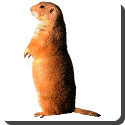 Groundhog — The groundhog (Marmota monax), also known as the woodchuck, land beaver, or whistlepig, is a rodent of the family Sciuridae, belonging to the group of large ground squirrels known as marmots. Most marmots, such as yellow-bellied and hoary marmots, live in rocky and mountainous areas, but the woodchuck is a lowland creature. It is widely distributed in North America and common in the northeastern and central United States. In the west it is found only in Alaska, Alberta, British Columbia, and northern Washington.
Groundhog — The groundhog (Marmota monax), also known as the woodchuck, land beaver, or whistlepig, is a rodent of the family Sciuridae, belonging to the group of large ground squirrels known as marmots. Most marmots, such as yellow-bellied and hoary marmots, live in rocky and mountainous areas, but the woodchuck is a lowland creature. It is widely distributed in North America and common in the northeastern and central United States. In the west it is found only in Alaska, Alberta, British Columbia, and northern Washington.
The groundhog is the largest sciurid in its geographical range, typically measuring 40 to 65 cm (17 to 26 in) long (including a 15 cm tail) and weighing 2 to 4 kg (4.5 to 9 pounds). In areas with fewer natural predators and large quantities of alfalfa, groundhogs can grow to 80 cm (32 in) and 14 kg (30 lb). Groundhogs are well adapted for digging, with short but powerful limbs and curved, thick claws. Unlike other sciurids, the groundhog’s spine is curved, more like that of a mole, and the tail is comparably shorter as well – only about one-fourth of body length. Suited to their temperate habitat, groundhogs are covered with two coats of fur: a dense grey undercoat and a longer coat of banded guard hairs that gives the groundhog its distinctive “frosted” appearance. Like other sciurids, groundhogs have exceptionally dense cerebral bones, allowing them to survive direct blows to the head that would cripple other mammals of the same body mass. Groundhogs usually live from two to three years, but can live up to six years in the wild, and up to ten in captivity[citation needed]. Common predators for groundhogs include wolves, coyotes, bobcats, bears, large hawks, and owls. Young groundhogs are often at risk for predation by snakes, which easily enter the burrow.
 Kids Portal For Parents India Kids Network
Kids Portal For Parents India Kids Network






